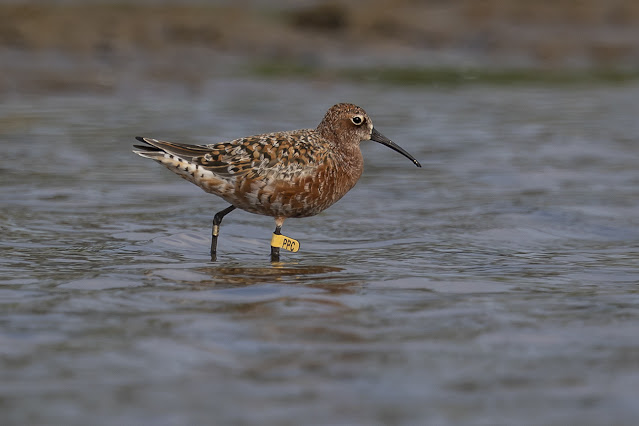Po Toi is traditionally our best birding spot in Hong Kong to spot migrants, it is our most southerly island and often attract a good number of migrants. Over the years this is one of the best birding spot to look for rarity during spring and autumn, with some pretty incredible sightings in the past.
Last week someone spotted a Brown-eared Bulbul on the island, this is only the 4th record in Hong Kong, with previous 3 records all just one day birds. While this is a very common species in Japan, they rarely venture to southern China, with most records concentrated to Taiwan and the east coast of China. Since the bird continued to be seen throughout the week, I thought I may as well give it a try. Luckily for me, it stayed on and after a little bit of effort on the island, I got some good views of it perched on top of a bare branch. This bird was extremely mobile, it was seen flying from one end of the island to the other, the best strategy in the end was just to stand at one spot and wait for it to come through.
 |
| Brown-eared Bulbul - a Hong Kong tick for me |
 |
| Brown-eared Bulbul - showing the interesting undertail coverts |
It was quite a misty day with a bit of drizzle in the air, the continued easterly winds probably helped to bring in a few birds as well. There were plenty of birds to see as we waited for the bulbul, including a male Chestnut Bunting, a male Black-naped Oriole and a few Eyebrowed Thrush. Dollarbirds were also seen, but they were perched too far away that I didn't bother taking any photos.
 |
| Chestnut Bunting - male |
 |
| Black-naped Oriole - male |
 |
| Eyebrowed Thrush |
There was a flock of four minivets, initially I thought they were all Ashy Minivets as I saw a female perched on top of a tree, on closer inspection however revealed that the other three were actually Swinhoe's Minivets! While they are regular passage migrants in Hong Kong, Swinhoe's Minivets are considerably less common than Ashy Minivets. They gave great views for me despite perching a bit high up. The two species look quite similar, but Swinhoe's Minivets have buffish underside, while Ashy Minivets always have very pale underside.
 |
| Ashy Minivet - female |
 |
| Swinhoe's Minivet - male |
Along the mangrove a distant Black-capped Kingfisher showed briefly, I relocated it perched even further away into the forest later on. A Eurasian Hoopoe was a lot friendlier, this one perched only a few metres away from me for a couple of minutes, allowing me to get a few good shots before flying off.
 |
| Black-capped Kingfisher |
 |
| Eurasian Hoopoe |
There were good numbers of Chinese Sparrowhawks around, most were seen in flight, but some occasionally will perch for a decent view, such as this nice looking male.
 |
| Chinese Sparrowhawk - female |
 |
| Chinese Sparrowhawk - male |
Other birds seen in the air were numerous Pacific Swifts. A couple of Grey-faced Buzzards came through, this is another classic migrant raptor in Hong Kong, some flew low enough for me to grab some decent photos. Two birds were seen chasing each other in the air at great speed, which I initially thought were two Chinese Sparrowhawks fighting, I was a bit surprise when I reviewed the photos that it was actually a Japanese Sparrowhawk chasing an Oriental Cuckoo!
 |
| Pacific Swift |
 |
| Grey-faced Buzzard |
 |
| Japanese Sparrowhawk & Oriental Cuckoo |
Over at San Tin, there isn't a lot of new arrivals, a small flock of Sand Martins were the best I could manage, I spent a little bit of time trying to get some photos of them in flight, here are a few that turned out decent enough.
 |
| Sand Martin |
Over at Mai Po, many migrating waders are still coming through, I got some closer views of Black-tailed Godwits on the scrape the other day, while a Great Knot came up really close to the bird hide, allowing for some closeup shots. Whimbrels are also in quite good numbers now. A Black Kite came through and flushed everything up in the air, turns out it actually snatched a Red-necked Stint from the flock, the Black Kites in Mai Po is actually quite peculiar in that they actively hunt for birds instead of just feeding on carrion.
 |
| Black-tailed Godwit |
 |
| Great Knot |
 |
| Eurasian Whimbrel |
 |
| Black Kite with Red-necked Stint |
A single Pallas's Gull remains, which is quite unusual as we don't usually get them staying on this late, this is a non-breeding bird so there is actually a chance it may over summer here in Mai Po. Many Black-faced Spoonbills are still around, as well as a few Eurasian Spoonbills.
 |
| Pallas's Gull |
 |
| Black-faced and Eurasian Spoonbill |
Cattle Egrets are now in full breeding plumage, many were seen on the buffalo field at Mai Po, posing next to water buffalos in the most classic fashion. Good numbers of Chinese Penduline Tits can still be found around the reedbeds, although close views still require a bit of luck! Red-throated Pipits are still around, although numbers seems to have dropped from earlier in the month.
 |
| Cattle Egret |
 |
| Chinese Penduline Tit - female |
 |
| Red-throated Pipit |
One of my better find at Mai Po were a few Blue-tailed Bee-eaters, having missed them last year I was very happy to connect with them again! While this is actually a very common species in South East Asia, here in Hong Kong we only get them as a scarce passage migrant.
 |
| Blue-tailed Bee-eater |



































































